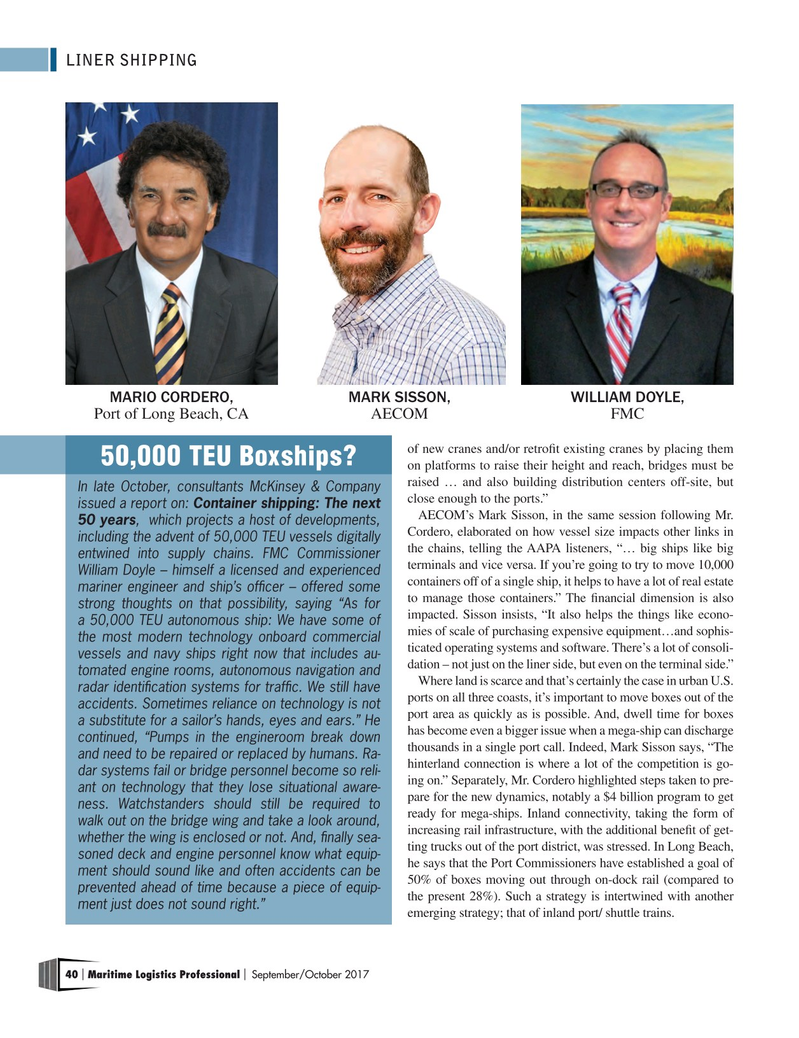
Page 40: of Maritime Logistics Professional Magazine (Sep/Oct 2017)
CONTAINER PORTS
Read this page in Pdf, Flash or Html5 edition of Sep/Oct 2017 Maritime Logistics Professional Magazine
LINER SHIPPING
MARIO CORDERO, MARK SISSON, WILLIAM DOYLE,
Port of Long Beach, CA AECOM FMC of new cranes and/or retroft existing cranes by placing them 50,000 TEU Boxships?
on platforms to raise their height and reach, bridges must be raised … and also building distribution centers off-site, but
In late October, consultants McKinsey & Company close enough to the ports.” issued a report on: Container shipping: The next
AECOM’s Mark Sisson, in the same session following Mr. 50 years, which projects a host of developments,
Cordero, elaborated on how vessel size impacts other links in including the advent of 50,000 TEU vessels digitally the chains, telling the AAPA listeners, “… big ships like big entwined into supply chains. FMC Commissioner terminals and vice versa. If you’re going to try to move 10,000
William Doyle – himself a licensed and experienced containers off of a single ship, it helps to have a lot of real estate mariner engineer and ship’s offcer – offered some to manage those containers.” The fnancial dimension is also strong thoughts on that possibility, saying “As for impacted. Sisson insists, “It also helps the things like econo- a 50,000 TEU autonomous ship: We have some of mies of scale of purchasing expensive equipment…and sophis- the most modern technology onboard commercial ticated operating systems and software. There’s a lot of consoli- vessels and navy ships right now that includes au- dation – not just on the liner side, but even on the terminal side.” tomated engine rooms, autonomous navigation and
Where land is scarce and that’s certainly the case in urban U.S. radar identifcation systems for traffc. We still have ports on all three coasts, it’s important to move boxes out of the accidents. Sometimes reliance on technology is not port area as quickly as is possible. And, dwell time for boxes a substitute for a sailor’s hands, eyes and ears.” He has become even a bigger issue when a mega-ship can discharge continued, “Pumps in the engineroom break down thousands in a single port call. Indeed, Mark Sisson says, “The and need to be repaired or replaced by humans. Ra- hinterland connection is where a lot of the competition is go- dar systems fail or bridge personnel become so reli- ing on.” Separately, Mr. Cordero highlighted steps taken to pre- ant on technology that they lose situational aware- pare for the new dynamics, notably a $4 billion program to get ness. Watchstanders should still be required to ready for mega-ships. Inland connectivity, taking the form of walk out on the bridge wing and take a look around, increasing rail infrastructure, with the additional beneft of get- whether the wing is enclosed or not. And, fnally sea- ting trucks out of the port district, was stressed. In Long Beach, soned deck and engine personnel know what equip- he says that the Port Commissioners have established a goal of ment should sound like and often accidents can be 50% of boxes moving out through on-dock rail (compared to prevented ahead of time because a piece of equip- the present 28%). Such a strategy is intertwined with another ment just does not sound right.” emerging strategy; that of inland port/ shuttle trains. 40 Maritime Logistics Professional September/October 2017 | |

 39
39

 41
41
